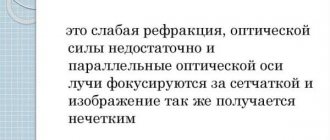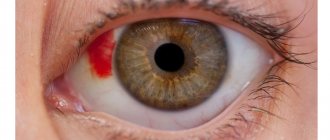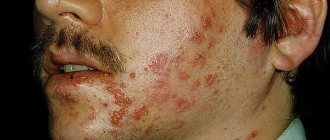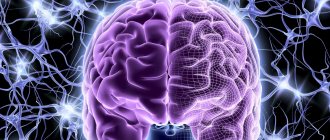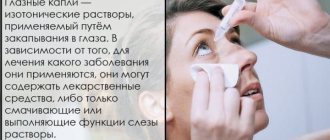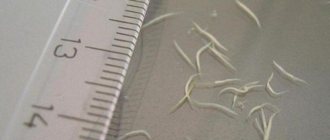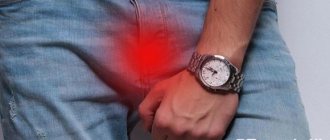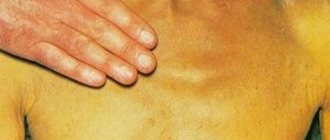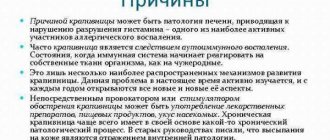Synonyms: presbyopia, senile farsightedness, age-related farsightedness.
ICD-10 code: H52.4.
Author: Andriyanov G.Yu., therapist, statistician. January, 2020.
Presbyopia is a pathology that is characterized by a deterioration in the vision of objects at close range, while distant objects are perceived normally.
It is not considered a disease, but a physiologically natural process caused by the aging of the body in general and the eyes in particular.
The pathology is associated with the aging of the lens, which with age loses the ability to accommodate (curvature), as a result of which the refraction of light rays is disrupted and the image is focused not on the retina, but behind it, which causes its blurriness.
The average age of detection of pathology is 40-45 years. If the patient suffers from hyperopia (farsightedness), then presbyopia develops earlier, and with myopia (myopia) later. Interestingly, the higher the degree of myopia, the lower the risk of developing presbyopia.
Senile farsightedness always affects both eyes, so when presbyopia is mentioned, it means a disease of both eyes. According to Russian ophthalmological statistics, presbyopia in people 30-39 years old is about 5%, in people 40-49 years old - 25%, in people 50-59 years old - 68%.
Causes
The development of presbyopia is based on the physiological processes of aging of the body in general and in the visual organs in particular. This leads to a natural weakening of accommodation - the ability of the eye to adapt to viewing objects at different distances (near and far).
The mechanism for the development of presbyopia is sclerotic transformations of the lens, which are accompanied by its dehydration, hardening and loss of elasticity. Also, the ciliary muscle undergoes dystrophic changes, in which muscle tissue is replaced by connective tissue, which impairs its contractility.
As a result of these changes, the lens loses the ability to change its curvature in the direction of increasing it, which affects the difficulty of viewing objects close to the eyes.
Factors that accelerate the onset of presbyopia:
- uncorrected farsightedness;
- work that requires constant eye strain (reading texts with small print, working at a computer, watchmakers, laboratory assistants);
- frequent infectious diseases (flu, meningitis, measles and others);
- frequent use of a number of medications, including antiallergic, antispasmodic and diuretic drugs;
- eye diseases (glaucoma, cataracts), history of ophthalmological surgeries, eye injuries;
- frequent eye infections (blepharitis, conjunctivitis, uveitis, keratitis);
- heredity;
- cardiovascular pathology (hypertension, circulatory failure, atherosclerosis);
- systemic pathology (diabetes mellitus, multiple sclerosis);
- unbalanced diet, as a result of vitamin deficiency;
- Poor lighting when doing small work or reading.
How does presbyopia manifest?
People with normal vision note the appearance of the first symptoms of presbyopia at 40–45 years of age. This is manifested by rapid visual fatigue (accommodative asthenopathy) during activities that require close examination of objects (writing, embroidering, reading, assembling and sorting small parts).
Accommodative asthenopathy is manifested by headaches, dull pain in the eyes, bridge of the nose and brow ridges, and visual fatigue. Symptoms such as lacrimation along with photophobia often occur.
A person suffering from presbyopia sees nearby objects blurry and indistinct, which causes him an instinctive desire to move the object in question further from the eyes and increase the lighting.
A subjective sign of developing pathology is when a person over 40 years old strives to remove the object of consideration from the eyes by 30 centimeters or more.
Further deterioration of the accommodation process continues until the age of 65; at approximately this age interval, the distance to the nearest point of clear vision coincides with the distance to the farthest clearly visible point. Accordingly, accommodation in this case is zero (the lens does not bend).
William Bates Method
The set of exercises is aimed primarily at relieving eye strain due to farsightedness. This is precisely what the famous ophthalmologist saw as the main cause of visual disorders.
The exercises he suggests to improve vision are simple and easy to do.
- While reading, you need to periodically look at the spacing between lines.
- Going outside, look at a monochromatic object: blue sky, green grass. Then look at the special letter table.
- Watch closely for moving objects.
The main exercise is working with a table specially developed by Bates for vision correction. It depicts small symbols, which must be viewed without the use of glasses or lenses, devoting a quarter of an hour of your time to this daily.
Diagnostics
Here is an image of Landolt rings:
- Wear glasses or contact lenses if you use them.
- You must sit at least 35cm away from the computer screen.
- Look at the image with both eyes open.
- Write down which side there is a gap in the rings (right, left, top, bottom)
- If you did not see all the rings correctly, then repeat this experiment the next day.
- If on the second day you again do not see the ring correctly, then it is advisable to consult an ophthalmologist.
Presbyopia should be distinguished from acute infectious eye diseases (conjunctivitis), which are accompanied not only by deterioration of vision both near and far, but also by lacrimation, burning in the eyes, redness and swelling of the eyelids.
Patients also often confuse presbyopia with computer vision syndrome—a decrease in visual acuity due to prolonged work at the computer. However, if the first symptoms began after the age of 40, the ophthalmologist will most likely see presbyopia.
Diagnosis of pathology, in addition to a thorough study of complaints and anamnesis, includes the following research methods:
- Visometry. Helps determine visual acuity using special Sivtsev-Golovin tables, which depict letters and pictures.
- Automatic refractometry. Helps study the refraction of the eye (the refraction of light in the organ of vision) using a refractometer.
- Skiascopy. Complements refractometry in the study of eye refraction.
- Ophthalmometry. A special device is used - an ophthalmometer, which allows you to measure the curvature of the cornea.
- Ophthalmoscopy, biomicroscopy. Other ocular structures (retina, optic disc, fundus vessels) are examined under magnification.
- Tonometry. Makes it possible to measure intraocular pressure and exclude/confirm glaucoma.
- Gonioscopy. Allows you to study the anterior chamber of the eyeball, identify glaucoma and a number of congenital/acquired anomalies.
- Ultrasound scanning of the eyes. It makes it possible to identify various diseases and changes in the eyeballs, allows you to assess the condition of the muscles, blood vessels, and nerves of the visual organs.
- Selection of lenses. After examining visual acuity, the ophthalmologist selects suitable lenses from a special set located in the office.
Photo: checking visual acuity using Sivtsev-Golovin tables.
Selection of glasses
The initial correction of presbyopia is carried out using glasses. A person with age-related farsightedness needs plus lenses that increase the refractive power of the eye. Depending on the degree of hypermetropia, strong or weak glasses are prescribed.
Spectacle correction of presbyopia has no contraindications. A person with mild presbyopia only needs to wear glasses while working or reading. Constant wearing of optics is recommended for people with a severe stage.
Treatment
Presbyopia is treated by an ophthalmologist. Treatment tactics are determined by the condition of the patient’s eyes, his age, lifestyle and type of work activity. Pathology therapy includes vision correction using optical, laser or microsurgical methods.
Optical correction
The most common treatment method, the essence of which is the selection of collective “plus” lenses. Correction is more often carried out with glasses, the strength of the lenses in which depends on the age of the person. For example, for people with initially normal vision at the age of 40, lenses from +0.75 to +1 diopters are prescribed, then every 5 years the lenses are replaced with stronger ones at the rate of +0.5 diopters. Accordingly, in a 45-year-old patient the glass strength should be + 1.5 diopters, in a 50-year-old patient +2 diopters, and so on. When reaching the 65-year mark, no strengthening of the correction is carried out, so accommodation reaches 0.
For patients with farsightedness, the calculation of the optical power of lenses is carried out as follows: the degree of farsightedness + the addition of diopters necessary to correct presbyopia according to age. For persons with myopia, the degree of myopia is deducted from the age-appropriate presbyopic lens power. But the selection of lenses for both myopia and farsightedness is necessarily carried out by directly applying them to the eyes.
Taking into account the patient’s work activity and lifestyle, he may be prescribed:
- glasses for close work;
- bifocal glasses, which have 2 focuses, allowing you to see far and near;
- progressive or multifocal lenses;
- combined lenses (one for long distance, one for close).
In Britain, at the end of 2020, a study was completed in which Eyelike Pinhole II soft contact lenses were highly effective. They will probably appear on the Russian market soon.
In addition to optical vision correction, the specialist will prescribe medication (vitamin eye complexes, drops to eliminate eye fatigue, artificial tears) and physical therapy (neck-collar massage, reflexology, etc.) - additional measures themselves will not lead to improved vision, but can reduce rate of vision deterioration.
The ophthalmologist will also recommend performing simple eye exercises, which are aimed at training the eye muscles and improving blood supply to the eye tissues.
Surgical correction
This is a radical and most effective method of treating presbyopia. Several surgical options are possible:
- Monovision (LASIK). The essence of the operation is that as a result, the dominant eye sees close objects well, and the non-dominant eye sees distant objects. This method is contraindicated for those people who need good stereoscopic vision (for example, pilots).
- Laser correction. A laser creates a multifocal surface on the cornea, allowing you to see far and near. Recently, technology has been considered the safest and most progressive.
- Photorefractive keratectomy. The upper epithelial layer of the cornea is removed.
- Lens replacement (one- or two-sided). Artificial implants or donor material are used. Allows you to restore vision to normal levels for a long time.
It is worth noting that recently surgical vision restoration has become increasingly popular, techniques are becoming more diverse, and the number of complications and negative effects is decreasing. However, glasses or contact lenses still remain the classic vision correction for presbyopia.
Effective exercises for farsightedness
When choosing a set of exercises for farsightedness for the eyes, you need to take into account age characteristics, causes and degree of the disease. Therefore, only a doctor can determine whether exercise will bring benefit or harm in each specific case. You cannot prescribe gymnastics on your own without first consulting an ophthalmologist, as this can lead to a worsening of the situation.
For hypermetropia, there are exercises that are useful for each age category of patients separately. The training begins gradually, avoiding overwork.
For adults
The exercises described below must be performed at least 10 times in one session, sitting in a comfortable position.
- Look straight ahead. Smoothly turn your head, look to the left, and come back. Do the same manipulations again, but with your head turned to the right.
- Place a finger or other object in front of your eyes at a distance of 30 cm. Select the most distant point and peer at it for 35 seconds, then look at the tip of your finger. It is better to perform this exercise to restore vision on the street or near a window: this way you can find an object located at the maximum distance from the eyes.
- Look at the object in front, then at the tip of your own nose and back.
It is useful to do exercises for vision after relaxing exercises. Often it is necessary to relieve tension not only from the eyes, but also from the entire body. This improves cerebral circulation and increases the effectiveness of gymnastics for farsightedness in adults.
For children
The children's body is especially sensitive to overload, so charging time to improve vision is limited to 8 minutes. The exercises are performed in a calm environment, preferably in the morning, when the child has not yet become tired during the day. You need to sit comfortably, straighten your back, breathe evenly and deeply. At the end of training, the eyes require mandatory rest.
- As you inhale, lower your gaze downward and draw a circle with your eyes towards the right. Stop at the top point. Exhaling, continue moving to the bottom of the imaginary circle. You need to start this kind of training with one circle a day, gradually increasing their number to three. It is necessary to change the direction of eye movement; long breaks between approaches cannot be taken.
- Focus your gaze on the tip of your nose, inhaling deeply. As you exhale, look straight ahead.
- Without straining your eyes, smoothly move your gaze to the right side all the way and immediately return to the starting position. Repeat the exercise in the opposite direction.
Eye exercises for farsightedness in children, aimed at restoring vision, are not carried out daily. When to perform certain exercises and how much time to devote to exercises, only a doctor can determine with accuracy.
This rule does not apply to gymnastics that relieve visual tension. It should be done during breaks between lessons, doing homework, while reading or working on the computer. “Writing with the nose” is perfect for this, when a child, with his eyes closed, draws various shapes on an imaginary canvas with the tip of his nose. It’s better to lie down and relax, but you can just sit comfortably in a chair.
Read in a separate article: Exercises for strabismus: useful exercises and exercises for the eyes
For presbyopia - age-related farsightedness
Visual impairment after 40 years is a consequence of natural aging of the body. Some researchers believe that the process of developing farsightedness is accelerated by an unbalanced diet, as well as constant mental stress when trying to look at small objects located nearby.
Eye training for farsightedness caused by age-related changes involves strengthening the oblique muscles of the eyes.
Procedure for performing the exercise:
- sit comfortably;
- cover the healthy eye with your palm or the one that was affected to a lesser extent;
- extend your free hand forward, turning your palm towards you;
- study the lines on the palm for half a minute, trying to remember their location;
- close eyes
- imagine the lines you see;
- repeat the exercise, moving your hand alternately 15 and 40 cm from your face;
- After resting, perform the manipulations described above with your eyes open.
For age-related hypermetropia, the technique developed by W. Bates has proven itself to be effective.
Prevention and prognosis
Since presbyopia is an age-related change in the body, its occurrence cannot be prevented, but it is possible to delay its occurrence:
- maintaining a healthy lifestyle;
- rejection of bad habits;
- performing eye exercises, especially when working with eye strain;
- balanced diet with sufficient vitamins, microelements and nutrients;
- creating the right lighting;
- annual visits to an ophthalmologist, timely correction of refractive errors;
- correction of common chronic diseases.
The prognosis in case of adequate correction for presbyopia is favorable and increases the patient’s chances of maintaining sufficient visual acuity for a long time.
Sources:
- Podgornaya N.N. Elderly patient. Why does vision deteriorate? - Russian Medical Journal, No. 2 from 01/16/2002
- Nesterov A.P. Glaucoma is a controversial issue. Report at the conference “Current problems of glaucoma”. — Clinical ophthalmology, No. 2 from 07/11/2004
- Jun I., Cho JS. Clinical outcomes of a novel presbyopia-correcting soft contact lens with a small aperture. — Contact lens & anterior eye: the journal of the British Contact Lens Association, Dec 2020.
- Andrew A Dahl, MD. Presbyopia - Cause and Treatment. — Medscape, Apr 2020.
